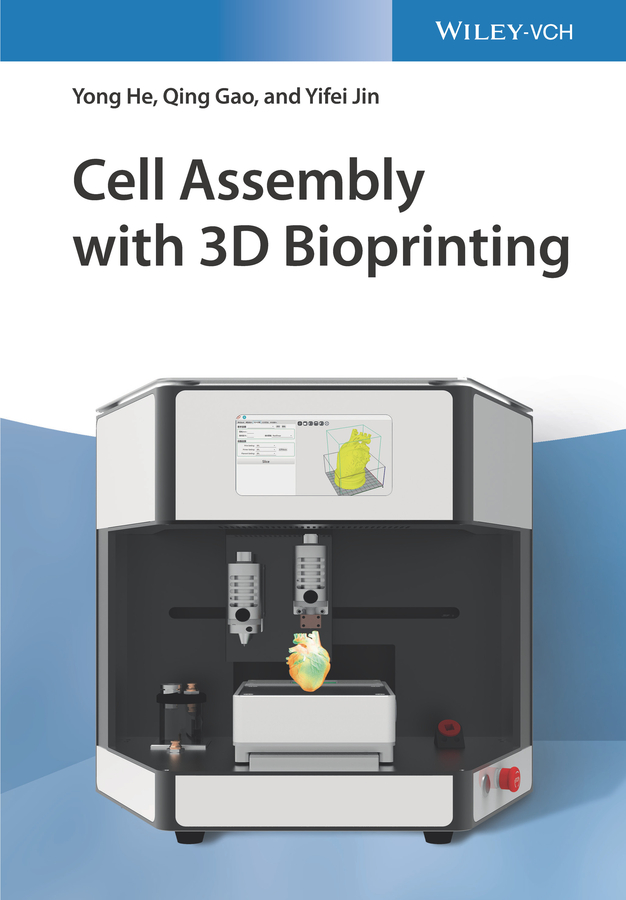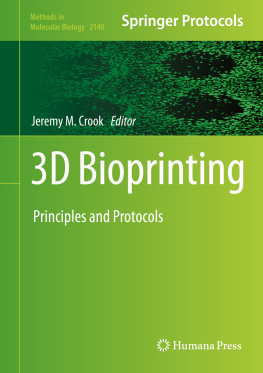Yong He - Cell Assembly with 3D Bioprinting
Here you can read online Yong He - Cell Assembly with 3D Bioprinting full text of the book (entire story) in english for free. Download pdf and epub, get meaning, cover and reviews about this ebook. year: 2022, publisher: John Wiley & Sons, genre: Science. Description of the work, (preface) as well as reviews are available. Best literature library LitArk.com created for fans of good reading and offers a wide selection of genres:
Romance novel
Science fiction
Adventure
Detective
Science
History
Home and family
Prose
Art
Politics
Computer
Non-fiction
Religion
Business
Children
Humor
Choose a favorite category and find really read worthwhile books. Enjoy immersion in the world of imagination, feel the emotions of the characters or learn something new for yourself, make an fascinating discovery.

Cell Assembly with 3D Bioprinting: summary, description and annotation
We offer to read an annotation, description, summary or preface (depends on what the author of the book "Cell Assembly with 3D Bioprinting" wrote himself). If you haven't found the necessary information about the book — write in the comments, we will try to find it.
Yong He: author's other books
Who wrote Cell Assembly with 3D Bioprinting? Find out the surname, the name of the author of the book and a list of all author's works by series.
Cell Assembly with 3D Bioprinting — read online for free the complete book (whole text) full work
Below is the text of the book, divided by pages. System saving the place of the last page read, allows you to conveniently read the book "Cell Assembly with 3D Bioprinting" online for free, without having to search again every time where you left off. Put a bookmark, and you can go to the page where you finished reading at any time.
Font size:
Interval:
Bookmark:

- Chapter 1
- Chapter 2
- Chapter 3
- Chapter 4
- Chapter 5
- Chapter 7
- Chapter 13
- Chapter 1
- Chapter 2
- Chapter 3
- Chapter 4
- Chapter 5
- Chapter 6
- Chapter 7
- Chapter 8
- Chapter 9
- Chapter 10
- Chapter 11
- Chapter 12
- Chapter 13
- Chapter 14
Yong He
Qing Gao
Yifei Jin

Authors
Prof. Yong He
School of Mechanical Engineering
Room 123, Teaching Building 1,
Yuquan Campus, Zhejiang University
No. 38, Zheda Road
310027 Hangzhou
China
Dr. Qing Gao
School of Mechanical Engineering
Room 123, Teaching Building 1,
Yuquan Campus, Zhejiang University
No. 38, Zheda Road
310027 Hangzhou
China
Prof. Yifei Jin
University of Nevada, Reno
Department of Mechanical Engineering
Room 230
1664 N. Virginia Street
NV
United States
Cover Image: Yong He
All books published by WILEYVCH are carefully produced. Nevertheless, authors, editors, and publisher do not warrant the information contained in these books, including this book, to be free of errors. Readers are advised to keep in mind that statements, data, illustrations, procedural details or other items may inadvertently be inaccurate.
Library of Congress Card No.: applied for
British Library CataloguinginPublication Data A catalogue record for this book is available from the British Library.
Bibliographic information published by the Deutsche Nationalbibliothek The Deutsche Nationalbibliothek lists this publication in the Deutsche Nationalbibliografie; detailed bibliographic data are available on the Internet at .
2022 WILEYVCH GmbH, Boschstr. 12, 69469 Weinheim, Germany
All rights reserved (including those of translation into other languages). No part of this book may be reproduced in any form by photoprinting, microfilm, or any other means nor transmitted or translated into a machine language without written permission from the publishers. Registered names, trademarks, etc. used in this book, even when not specifically marked as such, are not to be considered unprotected by law.
Print ISBN: 9783527347964
ePDF ISBN: 9783527828579
ePub ISBN: 9783527828586
oBook ISBN: 9783527828593
Cover DesignAdamDesign, Weinheim, Germany
3D bioprinting has opened up a frontier in biomedical research, aiming at additive manufacturing or assembling living structures with cells, which provides the possibility to generate significant breakthroughs, yielding new treatments, and change the foundation of regenerative medicine. It is truly an interdisciplinary field, crossfertilized ranging from mechanical engineering, materials science, and computer science to biology, medicine, pharmaceutical science, and so on.
The potential applications for 3D bioprinting include: (i) in vitro 3D tissue/organ models for drug screening, organ development, toxicological and cosmetic research, etc.; (ii) 3D biofabrication of living structures for clinical transplantation or tissue repair.
Compared to conventional additive manufacturing, 3D bioprinting possesses three remarkable characteristics: (i) bioprinting usually utilizes cellladen hydrogel (called bioink) in terms of material use; (ii) bioprinted structures have to go through hydrogel crosslinking process (thermal, chemical, or enzymatic) during formation for manufacturing desired tissue structures; (iii) crosstalking and functionalization of cells to acquire some tissue properties after printing is the goal. In these regards, bioprinting faces two major challenges: (i) structural controlled manufacturing, which requires a stable printing process to ensure cellladen hydrogels being accurately assembled. As the bioink is something like a soft tofu, precision manufacturing is difficult; (ii) functional controlled postprocessing, which needs to provide biomimetic microenvironment with physical and chemical stimulation for living constructs realizing functionalization.
Combined with our research experiences in 3D bioprinting over years, this book is outlined in 14 chapters: commonly used 3D bioprinting methods are summarized first; then the design of bioink is put forward; several bioprinting approaches are elaborated afterward including coaxial bioprinting, digital light projection, direct ink writing, and liquid support bathassisted 3D printing; in the following parts, microgelbased, microfiberbased, and microfluidicsbased biofabrication approaches and their applications are meticulously illustrated; and a protocol of 3D bioprinting is well represented in the end to show several examples of complete bioprinting process.
We wish to thank the valuable support from everyone who contributed to this book. This book would never have been published without your effort. Thanks to Dr. Zeming Gu for help in writing . Thanks to Zhengyi Zhang, Danyang Zhao, Lily Raymond, Heqi Xu, Matthew Warner, and Beatriz Godina for their help in completing this book. Thanks to Ms. Katherine Wong for editing the manuscript.
We sincerely hope that our readers will find the book professionally written, richly illustrated, accessible, and most importantly, intriguing. We would be flattered if this book attracts new researchers from different disciplines into the field of 3D bioprinting. Due to limited time and scholars with different backgrounds involved in compilation, there may be some unsatisfactory points in the writing style or content of this book. Therefore, readers are welcome to put forward criticism or suggestions for our further improvement.
4 May 2021 | Yong He Zhejiang University Hangzhou, China |
3D Bioprinting, A Powerful Tool for 3D Cells Assembling
3D printing, also known as additive manufacturing, is a layerbylayer manufacturing approach, and it has been applied in many industrial applications and research fields. It could be thought of as an inverse process of potato cutting, assembling the chips or slices into integrity by certain rules. When 3D printing met biomedical engineering, 3D bioprinting was born. 3D bioprinting is an interdisciplinary science closely related to medicine biology, mechanical engineering, and material science. It can be divided into two concepts. Broadly speaking, 3D bioprinting refers to the use of 3D printing technology to achieve biomedical applications, such as the printing of medical aids, polymers, ceramics, or metal scaffolds [.
In vitro biomanufacturing of tissues/organs has always been a great dream pursued by mankind, driven by two needs: organ transplantation and accurate tissue models. First, there is a huge shortage of organs for transplantation. In 2016, there were 160000 organ transplant recipients, but only 16000 organ donors in the United States []. The complexity of human organs is not only reflected in the mechanism of organ growth that has not been revealed by biology, but also in the reproduction of fine structure manufacturing. The use of 3D bioprinting technology to solve the shortage of organ transplants is far too optimistic at the present stage. Second, traditional methods utilizing 2D cell culture were applied for drug screening and medical mechanism studies. However, microenvironment in vivo is far more complex than the 2D cell culture, and in some cases, 2D models may lead to opposite results. 3D bioprinting technology can realize spatiotemporal directional manipulation of various cells and has become the most ideal method to construct a 3D cellladen structure in vitro.
Next pageFont size:
Interval:
Bookmark:
Similar books «Cell Assembly with 3D Bioprinting»
Look at similar books to Cell Assembly with 3D Bioprinting. We have selected literature similar in name and meaning in the hope of providing readers with more options to find new, interesting, not yet read works.
Discussion, reviews of the book Cell Assembly with 3D Bioprinting and just readers' own opinions. Leave your comments, write what you think about the work, its meaning or the main characters. Specify what exactly you liked and what you didn't like, and why you think so.








